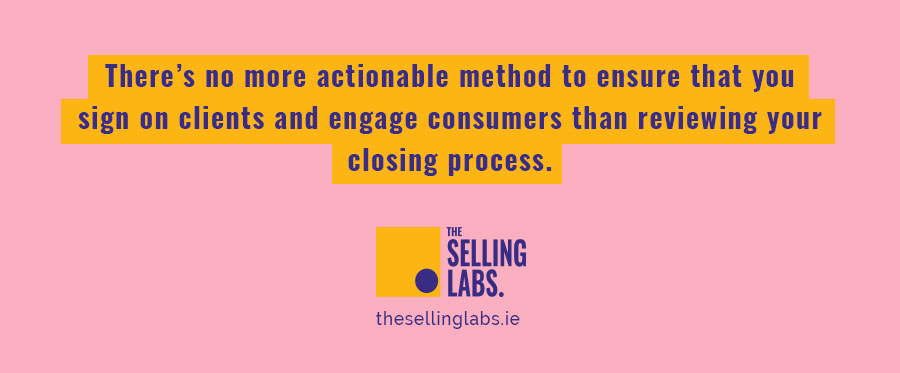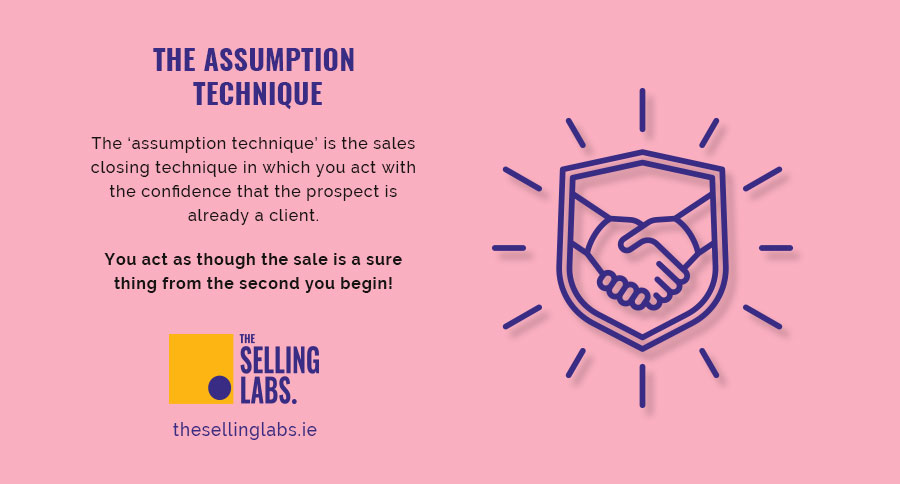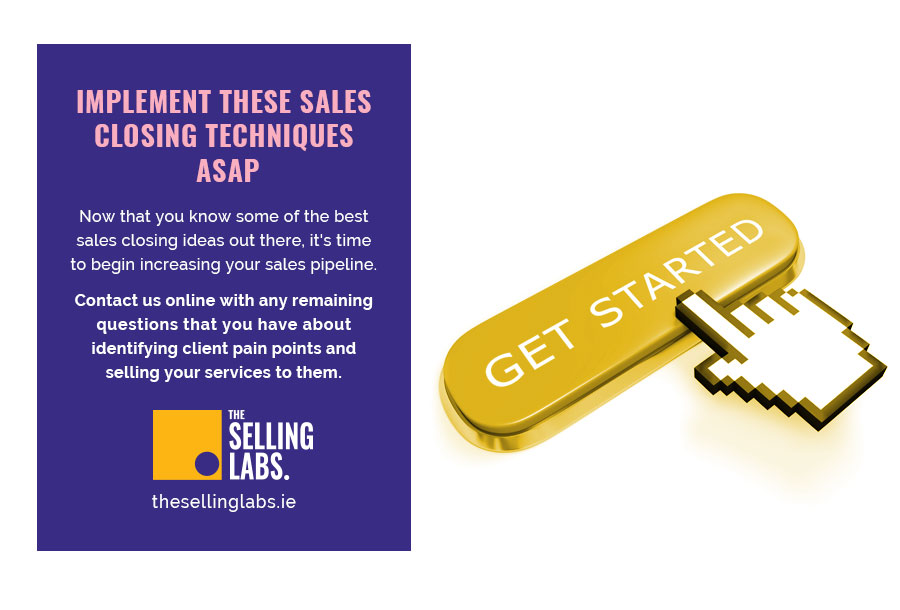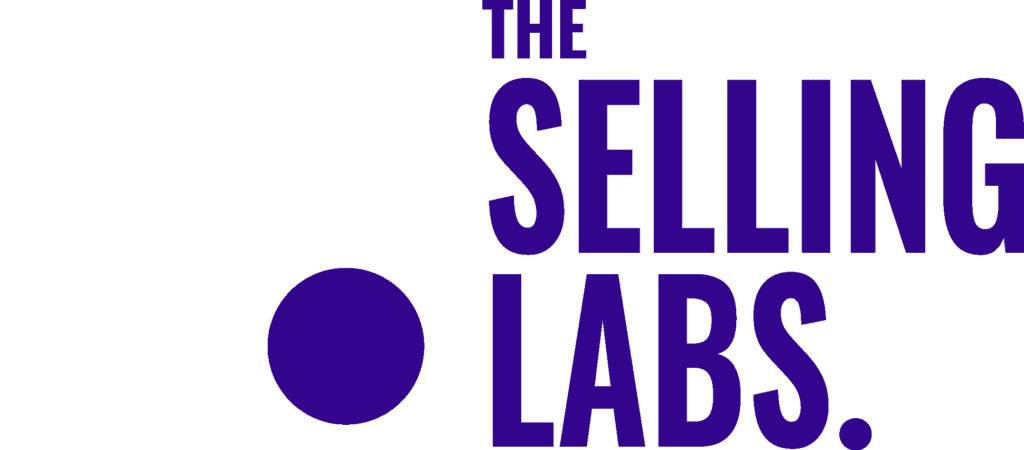Importance of Sales Closing Techniques
In a world where 20% of small businesses fail in their first year, knowing the best sales closing techniques – the most effective ways to agree a deal with your client – is essential to ensure your business is constantly building a solid base of new clients. There’s no more actionable method to ensure that you sign on clients and engage consumers than reviewing your closing process.
Here, we look at the top 5 methods of sales closing techniques that your business can use to grow. As sales consultants these are techniques we share with our clients to help them increase their sales. Read on to learn how you can ensure you engage positively with your clients and not become another startup fatality.

1. Pain Point Close
Before you make a sale, it’s critical that you understand the business context of your prospective client. When you address your client’s challenges head-on and confidently, you maximize the chances of your prospect appreciating how your product or services can benefit his or her business. You can untangle objections or concerns one by one, by putting yourself in his shoes and seeing the issue from his perspective
No matter what sales closing strategy you use, you need to first identify these pain points. Perhaps your client is struggling to get teams refocused after remote working, or feeling the pressure from increased competition in the market. Whatever the struggle is, building trust and rapport with your client by understanding how his business’s challenges are impacting his day-to-day working life will help you build a vision for a future when that struggle is eliminated. And you remain part of the future solution.
Once you have specific and clear answers to these questions, you can shape your offer in a way that resolves their particular challenge. For example, if the client’s business is struggling to bring in the right level of revenue growth to operate effectively, demonstrate how your product will specifically target stalling growth. Helping the client visualise the future state when this issue has been resolved (by your trusty product!) will help build momentum and commitment.
You will also have built trust and rapport by showing interest and that is an essential component in business.
2. Closing With a Question
Keep the insights you’ve gathered from the pain point close in mind as you practice with alternate ones. For example closing with the ‘question close’ requires you to ask probing questions to understand why a feature or strategy isn’t working, and it works hand in hand with the process of understanding a client’s pain points. The more you behave like a consultant and less like a salesperson the more effective and convincing you will be. Lets say your client’s existing technology isn’t working and their production is stalled. Asking questions to help them articulate their issues and untangle their issues by hearing it said out loud may facilitate your client to come to the realisation himself of the need for a new, alternative, improved solution.

This strategy works because you are helping the client believe that eliminating their old technical solution and selecting your improved one is a decision that has been arrived at without force or pressure. (Noone likes to be knowingly sold to)
Another type of question close is to articulate the value proposition, the specific sale of the client, in question form. Experiment with, ‘does what I am offering solve the specific issue that is leading to your pain point?’
This will let you discover whether the potential client is already viewing your product in a positive light. It also keeps the door open for further discussion in which you may be able to consider other areas for investment. You will have the chance to address your client’s objections while building trust and gaining commitment as you continue to engage.
3. The Assumption Technique
The ‘assumption technique’ is the sales closing technique in which you act with the confidence that the prospect is already a client. You use confident verbal and body language and insightful approaches; you assume doing business together is just a matter of time. You playfully act as though the sale is a sure thing from the second you begin! Rather than being duplicitous, your positive, can-do attitude is infectious and customer-focused and makes your soon-to-be-client feel that someone is working hard for them. Because of course, you will be adding value by giving advice and offering direction every step of the way. In giving that commitment, there is nothing assumed about the deal until you have provided utmost service.

Essentially, you’re speaking as though there’s no argument as to whether or not they’ll work with you. Act as though it’s simply a matter of when they choose to make the commitment.
Instead of discussing what will happen if the prospect works with you, talk about what will happen when they do. Rather than asking if they want to sign with you, ask what they want you to do for them when they sign with you.
This is effective for two key reasons. First, it’s an overwhelmingly positive way of thinking, and positivity tends to be contagious. Second, it uses the psychology of peer pressure indirectly and in a subtle way that won’t overwhelm the client.
4. Now or Never Closes
Once your client understands that the product will resolve his pain point, it’s time to keep up the momentum and focus on exemplary customer service all the way through to the hand shake. Now or never statements make sure that clients commit to working with you immediately.
Some ways that you can prompt immediate purchases include telling them:
- “You won’t receive the offer at this low price again – this is the last one we’re offering at this cost. The next affordable one is [x amount] more”
- “Customers who commit to purchasing today will receive a 30% discount”
- “Purchasing now means that you’ll be fast-tracked to the front of the queue for implementing the solution”

All of these statements create feelings of urgency within the prospect. They effectively make the client feel as though they need to buy immediately if they want to solve their pain point in the most inexpensive and efficient way possible. It also makes a client feel like they are your only one – and that feels good.
Ultimately, now or never closes help clients to overcome their trepidation and make an immediate purchase. They won’t have time to go over the pros and cons on their own later- they’ll only have time to reflect on the good decision they made.
5. Use a Sharp Angle
Sharp angle closes rely on the element of surprise when getting a new client to work with you. Many professionals hear sales pitches every day and will ask for discounts or similar perks. They know that you expect them to ask these questions and that you likely will be willing to offer it when prompted.
You need to deal with these negotiations in the smartest possible way. That’s where the Sharp Angle Close comes in.
Assuming that you have approval from your superiors, give them what they’re asking for. However, rather than doing this with no strings attached, give them a condition for you to meet their demands. An example of such a conversation would be:
Client: “Can I please have 20% off my first month of service? Competitors offer this perk.”
Sales rep: “Of course you can have 20% off, but only if you commit to working with us today.”
This is effective because you give the client what you want and keep them satisfied. However, at the same time, you get the firm commitment that you want. It’s a win-win situation, as all good negotiation tactics should be.

Implement These Sales Closing Techniques ASAP
Now that you know some of the best sales closing ideas out there, it’s time to begin increasing your sales pipeline. Contact us with any remaining questions that you have about identifying client pain points and selling your services to them.
Our experts not only have a unique background in technology and SaaS sales but also have expert knowledge in the ‘Google way’ of selling things. Since we’re committed to ensuring the success of your business, we look forward to hearing from you soon.
On Expert Sales Tips
Get regular updates delivered straight to your inbox with expert sales tips for tech & SaaS companies. Enter your email below and start to increase your sales now.



